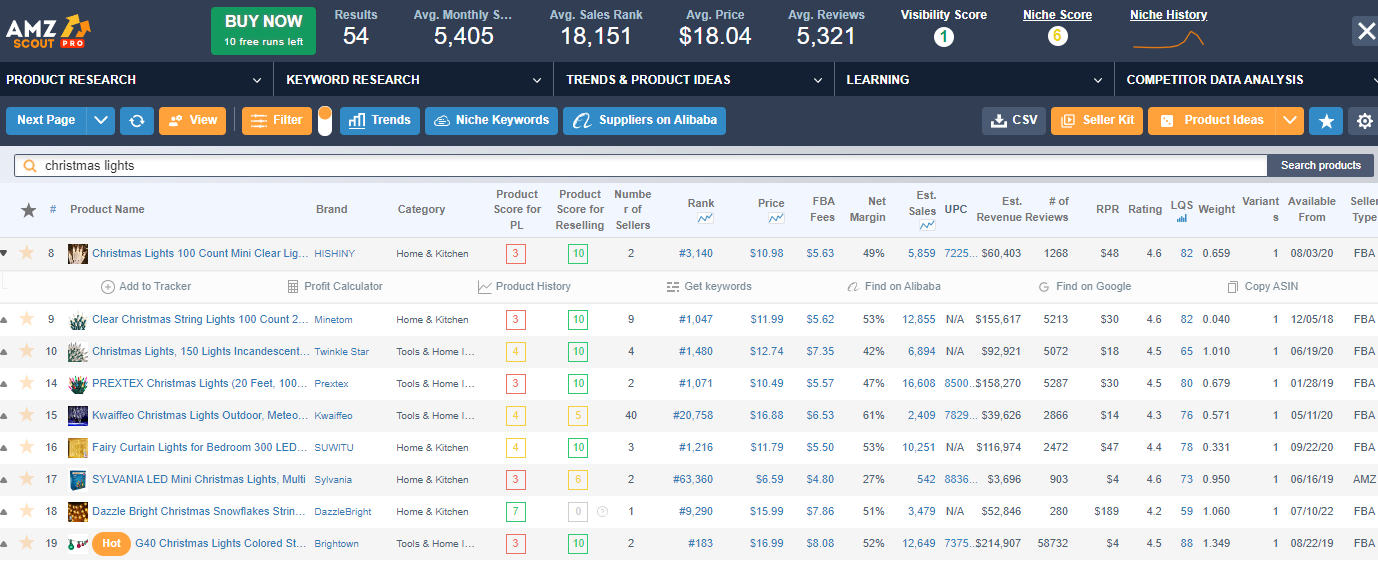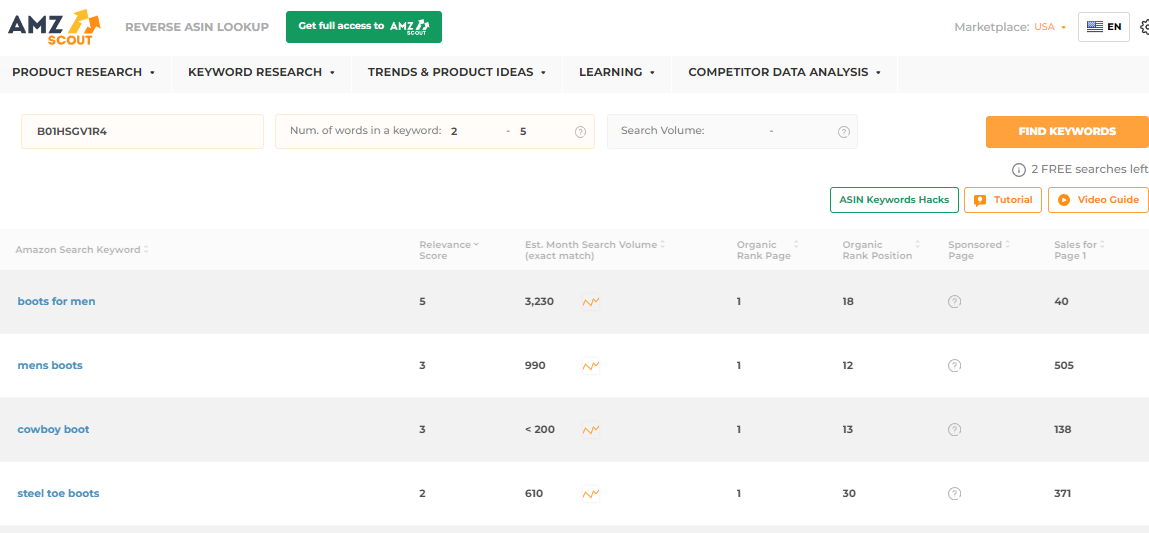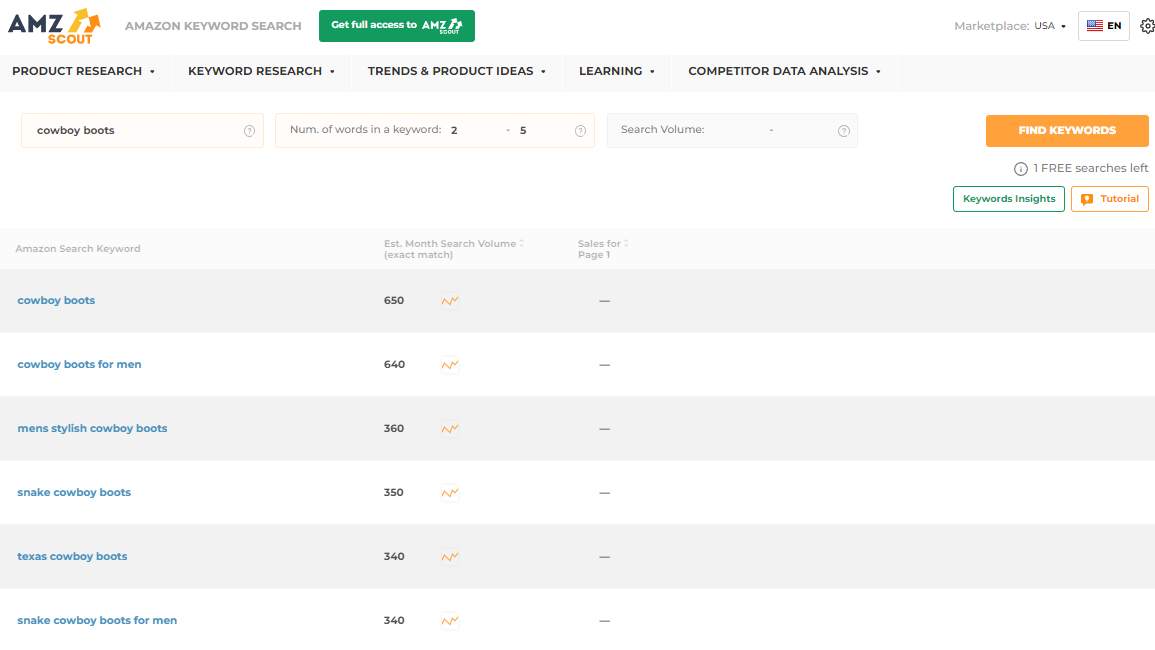AFFILIATE MARKETING
Best Research Tool For Amazon FBA Beginners?

Could AMZScout hold the key to starting a profitable Amazon business in your spare time?
It just might.
After all, product research is arguably the single most important factor when it comes to successfully selling on Amazon.
Choose the right products, and you’ve got a solid foundation to build on.
But pick wrong, and you’ll struggle to get anywhere at all.
In this quick review, we’ll see how AMZScout can help you make the best product choices and determine if this is the right Amazon research tool for you.
AMZScout Overview
-
Ease of Use
-
Stability
-
Price
Summary
AMZScout is the Swiss Army knife of Amazon product research software, offering a tool for every purpose. With attractive pricing options and a strong suite of training videos, AMZScout is a great choice when starting your Amazon business. Click here to take it for a test drive.
Pros
- Pro Plugin makes niche research easy
- Product tracker helps you avoid making decisions based on short-term spikes
- Product Database lets you get super detailed in your product research
- Training is easy to follow and some of the best around for Amazon beginners
- Affordable
Cons
- You have to install a lot of Chrome extensions to get full functionality
- Product Tracker only shows information from the point you add an item forward
- Not as full-featured as some competitors
What Is AMZScout?
As mentioned above, AMZScout is an Amazon research tool at its core, providing a suite of functionality to help you find the right niche and products for your business.
And, like most modern software, AMZScout is primarily a web application.
But to really appreciate all that AMZScout can do, we need to dig into its key features.
AMZScout Features
As it turns out, AMZScout is far from a one-trick pony.
Indeed, the features that AMZScout brings to the table can be broken into three broad categories: product research, keyword research, and training.
Product Research
Product research is AMZScout’s bread and butter, and it all starts with the Product Database, which is where you land when you log in to the web app:
The Product Database lets you search across 10 different Amazon marketplaces by keyword or category, and you can filter by up to 16 parameters, including product weight, price, reviews, etc.
If it sounds like there’s a lot happening on the Product Database dashboard, that’s because there is.
It can be a little overwhelming at first, but you’ll start to get the hang of it after a few searches. And the table of results delivers a ton of useful information about each product, including:
- Amazon category and subcategory
- Product rank in the category and subcategory
- Number of monthly sales
- Per-unit profit
- Product ratings and number of reviews
The Product Database also shows competitor information like the number of sellers for each product and its Listing Quality Score, or LSQ.
The LSQ is a metric AZMScout developed to give you a quick idea of how tough the competition is. It takes into account factors like brand and item name length, number of bullet points and images in the listing, and seller type.
Once you find a product you want to know more about, you can click through to see its Amazon listing or over to Alibaba to look into buying stock.
You can also add items from the main dashboard to the Product Tracker.
Product Tracker
As the name implies, the AMZScout Product Tracker allows you to monitor a product over time. Add your favorites here, and you get a table view that shows basic product information.
And you can click through to see even more details, as well as a graph of product performance over time:

One major drawback to this view is that the graph only shows product performance from the time you add it to the Product Tracker (and not before).
Pro Extension
This Chrome extension takes the basic functionality of the AMZScout Product Database and adds a little rocket fuel to your product research.
Just type in your search on Amazon, click on the Pro Extension icon in your Chrome toolbar, and voilà!
You get a table with the same sort of product information you see in the main AMZScout web app, along with a few extra goodies:

The turbo boost comes from the proprietary ratings that AMZScout displays on this screen:
- Product Score for Private Label: Is this a good candidate for private labeling? (higher score is better)
- Product Score for Reselling: Is this a good candidate for reselling? (higher score is better)
- Visibility Score: How many sellers are targeting this niche? (lower score is better)
But the Niche Score is particularly helpful when you’re just starting out. It rolls up all of the steps in Amazon product research into a single number to let you know whether you’re on the right track.
A score below 5 means the combination of demand, competition, and profit margin will make it tough for a newbie to succeed.
Get a Niche Score closer to 10, though, and your odds of finding success ratchet up in a hurry.
Of course, no one metric can guarantee results, but Niche Score can save you a lot of time as you’re narrowing in on a focus for your Amazon business.
Other Product Research Tools
Beyond these core utilities, AMZScout also offers up a few other tools to help you with product research:
- Monthly reports detailing emerging Amazon trends
- Weekly “hot products” reports that zero in on areas with exploding sales numbers
- Quick View – a Chrome extension for comparing products side-by-side from Amazon search results pages
- Stock Stats – another Chrome extension, this one for “spying” on your competitors’ stock levels
- Amazon Dropshipping, Arbitrage, and Wholesale – and one last (for now!) Chrome extension for evaluating how suitable a product is for each of these three business models (dropshipping, arbitrage, wholesale)
Keyword Research
Once you’ve decided on which products you want to sell (and figured out how to source them), you have to actually list them on Amazon.
But just throwing your products into that massive marketplace won’t get you very far.
No, to give your listings the best chance of turning up in user searches on Amazon, you need to ensure you’re targeting the right keywords…yeah, it’s hard to get away from SEO, even for business models outside of blogging!
Anyway, AMZScout provides another box of tools to help with keyword research.
Reverse ASIN Lookup
Enter an item’s ASIN, and this tool returns a list of keywords – along with information about search volume and competition – that you can use in your Amazon listings:

Amazon Keyword Research
This one’s a pretty straightforward keyword tool where you type in a seed phrase and get back a bunch of related keywords:

Keyword Tracker
The Keyword Tracker is a Chrome extension that lets you enter a product ASIN and then track the keywords that the product ranks for over time:

You can choose how often you want to update the information for each product, ranging from once an hour to once a day.
Training
Loading up on features is great, but they won’t do you much good if you don’t know how to use them…and why.
You need some training.
Luckily, this is one area where AMZScout really shines, especially if you’re just getting started on your Amazon trek.
The Amazon Private Label training is a 22-video course that walks you through every aspect of starting an Amazon business, from doing initial product research (surprise!) all the way to a tutorial on how to ship your product to Amazon FBA.
The first eight videos in the series are free, but you need a subscription to access the rest of the course.
Overall, this training is easy to understand and follow, and it’s one of the best courses around for Amazon beginners.
If you’re a bit more seasoned, you can jump into AMZScout’s Masterclasses offerings, which tackle more advanced topics, like pay-per-click ad strategies, sourcing local products, and international Amazon sales.
There’s also a “University” option, which offers up a series of premium courses (with matching premium prices) led by instructors with hands-on experience in building successful Amazon businesses.
How Much Does AMZScout Cost?
As of early 2023, AMZScout offers two basic subscription levels:
Pro Extension
The Pro Extension package gives you access to the Chrome extension plus the basic training courses. Pricing is $259.99 per year or $599.99 for lifetime access.
Note that this level does NOT give you access to the full-blown research tools or trend and product reports.
Seller’s Bundle for Amazon
The Seller’s Bundle gives you everything the Pro Extension package does but also adds on access to the full web application, as well as all the weekly and monthly reports.
Pricing is $49.99 per month, $379.99 per year, and $1599.99 for lifetime access.
Free Trial
The good news about all this is that you can try AMZScout for yourself with a free trial that gets you access to all the tools. And, unlike a lot of software trials, you don’t have to use a credit card to sign up – just an email address gets you in.
The free trial limits how many searches you can run, but it’s enough to get a pretty good feel for AMZScout’s capabilities.
You can sign up for the free trial on the AMZScout homepage.
AMZScout Alternatives
For as much as AMZScout offers, it’s far from the only game in town when it comes to tools for conducting your Amazon product research.
Jungle Scout is probably the most popular of them all and provides even more features than AMZScout, though at a higher price point.
But be sure to check out our Jungle Scout review to learn all about this excellent Amazon tool.
Helium 10 is another popular full-featured option that offers up several pricing options.
Brady Cook ran through all the major players in his article on Niche Pursuits: Need an Amazon Sales Estimator? Here Are Your 7 Best Options.
Definitely worth the read!
The Verdict
So, is AMZScout worth the price and time investment needed to learn how to use the tool?
If you’re just starting your Amazon business, the answer is a resounding “YES!”.
AMZScout gives you all the tools to pick a niche and specific products you want to sell. And the training modules alone will jumpstart you along your journey.
If you’re a little more experienced and want a more full-featured product, then AMZScout may not be the absolute best choice for you, especially when tools like Jungle Scout and Helium 10 don’t cost all that much more on a monthly basis.
The good news is, you have nothing to lose by taking advantage of AMZScout’s free trial…and maybe a whole lot to gain!
AFFILIATE MARKETING
AI Will Transform the Workplace. Here’s How HR Can Prepare for It.

Opinions expressed by Entrepreneur contributors are their own.
Our workplaces are about to undergo an unprecedented level of transformation, and HR will take center stage. Artificial intelligence will dramatically reshape HR in a way that goes beyond recruiting, hiring and talent management. Leadership teams at all levels need to embrace this change to transform and lead their organizations forward.
It’s the people, and not the technology, that makes AI initiatives a success. Intrapreneurs, in particular, are the driving force behind it. As I shared in Fearless Innovation, I noticed this when I was working on the innovation agenda for the Great Places to Work study — the most innovative companies were those that had a leadership team that was embracing intrapreneurship and were open to change.
HR is the beating heart of any organization, and as such, it needs to take center stage in both adopting and leading ethical and innovative AI transformation across the organization.
Related: How Artificial Intelligence Is Reinventing Human Resources
4 tectonic shifts AI will drive in HR
1. A new wave of massive reskilling
As AI becomes more prominent across business functions, the need for new skills will only grow. Forty percent of enterprise leaders believe that their workforce would need to reskill as a result of AI and machine learning. In fact, research shows almost a third of all hours worked in the U.S. could be automated by 2030.
All of us need to reskill to some extent to be relevant in the AI era. Not only would people need to re-train, but generative AI is introducing a whole host of professions that have been non-existent until recently, from AI ethicists to human-AI interaction designers. Some of these roles might sound futuristic, yet they are becoming increasingly relevant as technology advances.
2. The great restructure
As automation takes center stage across more business functions, there will be the inevitable need for organizations to restructure and rethink how they work. This transition will not only involve the integration of new technologies but also introduce a shift in the workforce dynamics. Intrapreneurs will need to identify gaps both in skills and operational processes and forge brand-new roles for themselves and those they manage. HR must play a key role in enabling a smooth and easy transition in this regard. The transition will not be smooth or easy, and it’s only HR that has the capability to make it impactful.
3. Arrival of “digital humans”
“Digital human” may sound like an oxymoron, but that’s the term that’s starting to appear in business and operational plans. More roles, regardless of industry, are becoming digitally enhanced where some form of AI assistance is embedded in their everyday work. A real-life example is the introduction of the digital nurse — AI-powered healthcare agents which have already been proven to outperform human nurses in certain tasks.
Imagine the impact these digital roles will have on the workforce the more sophisticated and prevalent they become. Eventually, HR will need to create policies and systems in place that account for this new type of “staff augmentation.”
4. Regulating the robot
The threat of AI bias and misuse is serious. Not only can the technology put many jobs at peril, but potential improper implementation can expose organizations to serious liability and negatively affect the workforce. From avoiding bias to inclusivity, HR teams play a critical role in the ethical deployment and management of AI technologies.
HR professionals will be tasked with navigating the delicate balance between leveraging AI for efficiency and ensuring that its application upholds fairness, privacy and non-discrimination.
What HR intrapreneurs must do to embrace AI the right way
The future of work is being shaped by AI adoption, and its success hinges on the right approach from the outset. My experience shows that for successful organizations, one universal trait stands out: the presence of change agents. Every organization, regardless of size, benefits from intrapreneurs who are open to change and committed to spearheading transformation efforts. These intrapreneurs are pivotal in driving the future of work, as they help orchestrate the integration of new technologies into their business models.
HR and talent leaders should harness this dynamic, encouraging a symbiotic relationship with intrapreneurs to develop customized solutions for AI adoption, ensuring that they are not just keeping pace with technological advances but are actively shaping their trajectory.
Securing a seat at the table:
HR should take a proactive stance in the adoption of AI, even if it is still in its early stages within your organization. By securing a position at the forefront of the AI initiative, HR can and should facilitate and guide the entire organization in embracing this significant change.
As AI has the potential to impact every facet of the organization, it is imperative for HR to not only understand and advocate for this technology but also lead its integration across all departments. HR should encourage and support intrapreneurs and all employees to leverage AI in their daily tasks, demonstrating its value not just for operational efficiency but for personal and professional growth as well.
Master the technology:
To effectively navigate and regulate AI, HR must first understand it thoroughly. Grasping the full potential of this technology is crucial for reaping its extensive benefits. HR plays a vital role in identifying the necessary tools and skills that employees must acquire and then integrating these learnings into daily work practices.
Before implementing AI more broadly, HR should initiate comprehensive training programs that not only educate but also reassure employees about AI’s role in the future of the business. By leading these educational initiatives, HR can shape the structure and effectiveness of these programs, ensuring they meet the needs of the organization and its workforce.
Related: 3 Ways to Prepare Your Business For an AI Future
Looking ahead
Generative AI has the transformative potential to redefine the business landscape, but realizing this vast potential hinges on more than just the adoption of technology. It critically depends on the talent within the workforce, driven by HR and bold intrapreneurs. These visionary leaders don’t just implement new tools; they exemplify their use, demonstrating the profound impact of AI across every level of the organization.
HR plays a pivotal role in fostering this environment, enabling intrapreneurs to guide and inspire every individual they touch. Together, they turn each employee into a catalyst for change, igniting a widespread passion for innovation that deeply resonates and sustains long-term success.
AFFILIATE MARKETING
Samsung: 6-Day Workweek For Execs, Company in Emergency Mode

Four-day workweeks might have all the buzz, but one major tech company is going in the opposite direction.
Samsung is implementing a six-day workweek for all executives after some of the firm’s core businesses delivered lower-than-expected financial results last year.
A Samsung Group executive told a Korean news outlet that “considering that performance of our major units, including Samsung Electronics Co., fell short of expectations in 2023, we are introducing the six-day work week for executives to inject a sense of crisis and make all-out efforts to overcome this crisis.”
Lower performance combined with other economic uncertainties like high borrowing costs have pushed the South Korean company to enter “emergency mode,” per The Korea Economic Daily.
Related: Apple Is No Longer the Top Phonemaker in the World as AI Pressure and Competition Intensifies
Executives at all Samsung Group divisions will be affected, including those in sales and manufacturing, according to the report.
Samsung had its worst financial year in over a decade in 2023, with the Wall Street Journal reporting that net profit fell 73% in Q4. It also lost its top spot on the global smartphone market to Apple in the same quarter, though it reclaimed it this year.
Though employees below the executive level aren’t yet mandated to clock in on weekends, some might follow the unwritten example of their bosses. After all, The Korea Economic Daily reports that executives across some Samsung divisions have been voluntarily working six days a week since January, before the company decided to implement the six-day workweek policy.
Entrepreneur has reached out to Samsung’s U.S. newsroom to ask if this news includes executives situated globally, including in the U.S., or if it only affects employees in Korea. Samsung did not immediately respond.
Research on the relationship between hours worked and output shows that working more does not necessarily increase productivity.
A Stanford project, for example, found that overwork leads to decreased total output. Average productivity decreases due to stress, sleep deprivation, and other factors “to the extent that the additional hours [worked] provide no benefit (and, in fact, are detrimental),” the study said.
Related: Samsung’s Newest Galaxy Gadget Aims ‘To See How Productive You Can Be’
Longer hours can also mean long-term health effects. The World Health Organization found that working more than 55 hours a week decreases life expectancy and increases the risk of stroke by 35%.
The same 55-hour workweek leads to a 17% higher risk of heart disease, per the same study.
AFFILIATE MARKETING
John Deere Hiring CTO ‘Chief Tractor Officer,’ TikTok Creator

This article originally appeared on Business Insider.
Agriculture equipment company John Deere is on the hunt for a different kind of CTO.
The brand on Tuesday announced a two-week search to find a “Chief Tractor Officer” who would create social media content to reach younger consumers.
One winning applicant will receive up to $192,300 to traverse the country over the next several months showcasing the way John Deere products are used by workers, from Yellowstone National Park to Chicago’s Wrigley Field and beyond.
“No matter what you do — whether it’s your coffee, getting dressed in the morning, driving to work, the building you go into — it’s all been touched by a construction worker, a farmer, or a lawn care maintenance group,” Jen Hartmann, John Deere’s global director of strategic public relations, told AdAge.
To kick off the search, John Deere tapped NFL quarterback Brock Purdy (who will presumably be a bit busy this Fall to take the job himself) to star in a clip in which he attempts to set out on a road trip in an industrial tractor.
Suited up in the obligatory vest, work boots, and John Deere hat, Purdy’s progress is interrupted by teammate Colton McKivitz hopping into the cab while a string of messages floods in from other athletes and influencers expressing interest in the job.
The clip also represents the first time that the 187-year-old company has used celebrities to promote itself, Hartmann told AdAge.
According to the contest rules, entrants have until April 29 at midnight to submit a single 60-second video making their pitch for why they should be the face and voice of the company.
In addition, entrants must live in the 48 contiguous states or DC — sorry Hawaii and Alaska residents. Interestingly, any AI-generated submissions are prohibited, too.
Videos will be judged against four categories — originally, creativity, quality, and brand knowledge — after which five finalists will be chosen and notified after May 17.
-

 SEO7 days ago
SEO7 days agoGoogle Limits News Links In California Over Proposed ‘Link Tax’ Law
-

 SEARCHENGINES6 days ago
SEARCHENGINES6 days agoGoogle Core Update Volatility, Helpful Content Update Gone, Dangerous Google Search Results & Google Ads Confusion
-

 SEO6 days ago
SEO6 days ago10 Paid Search & PPC Planning Best Practices
-

 MARKETING6 days ago
MARKETING6 days ago2 Ways to Take Back the Power in Your Business: Part 2
-

 MARKETING5 days ago
MARKETING5 days ago5 Psychological Tactics to Write Better Emails
-

 SEARCHENGINES5 days ago
SEARCHENGINES5 days agoWeekend Google Core Ranking Volatility
-

 PPC7 days ago
PPC7 days agoCritical Display Error in Brand Safety Metrics On Twitter/X Corrected
-

 MARKETING6 days ago
MARKETING6 days agoThe power of program management in martech














You must be logged in to post a comment Login